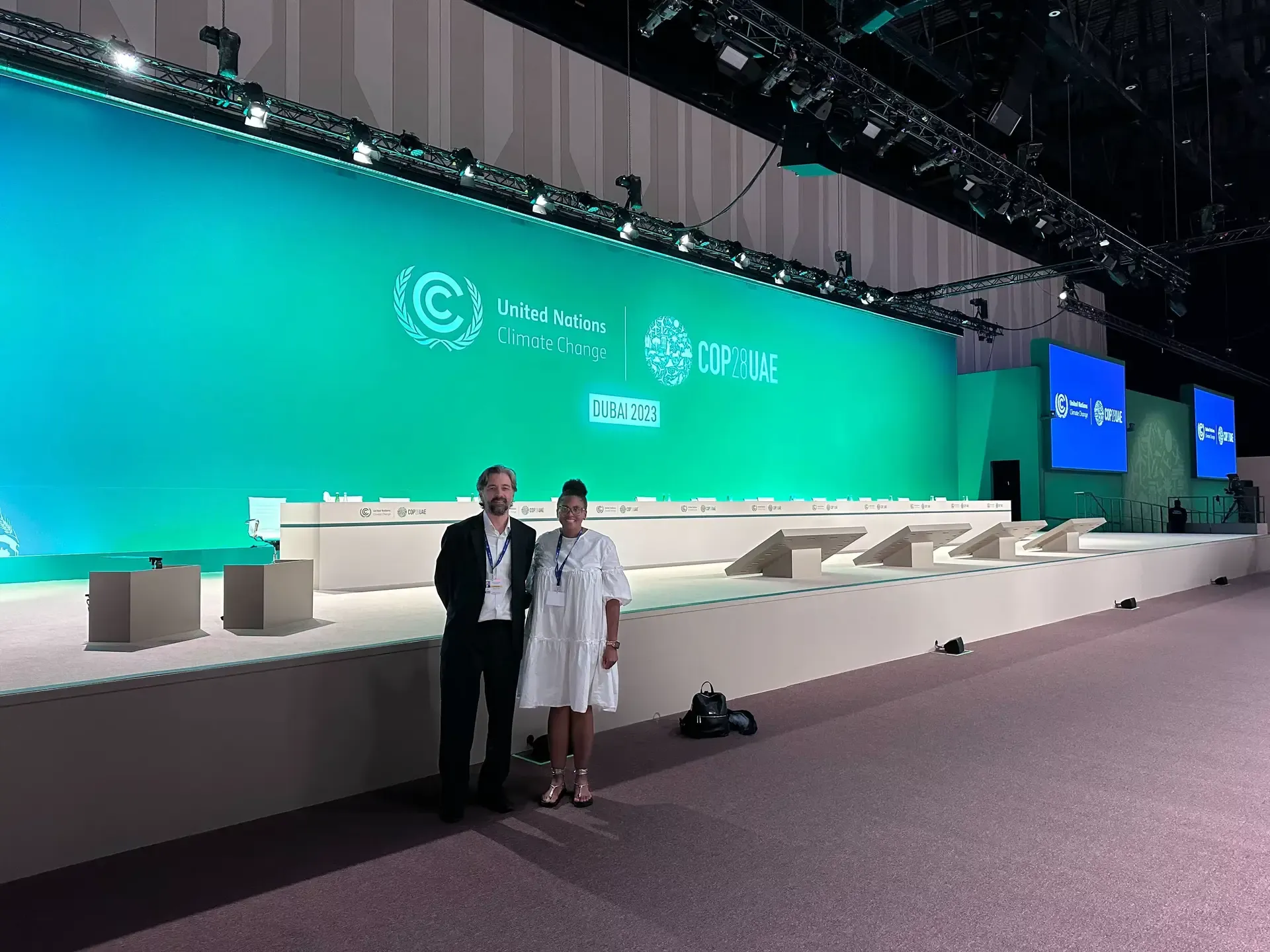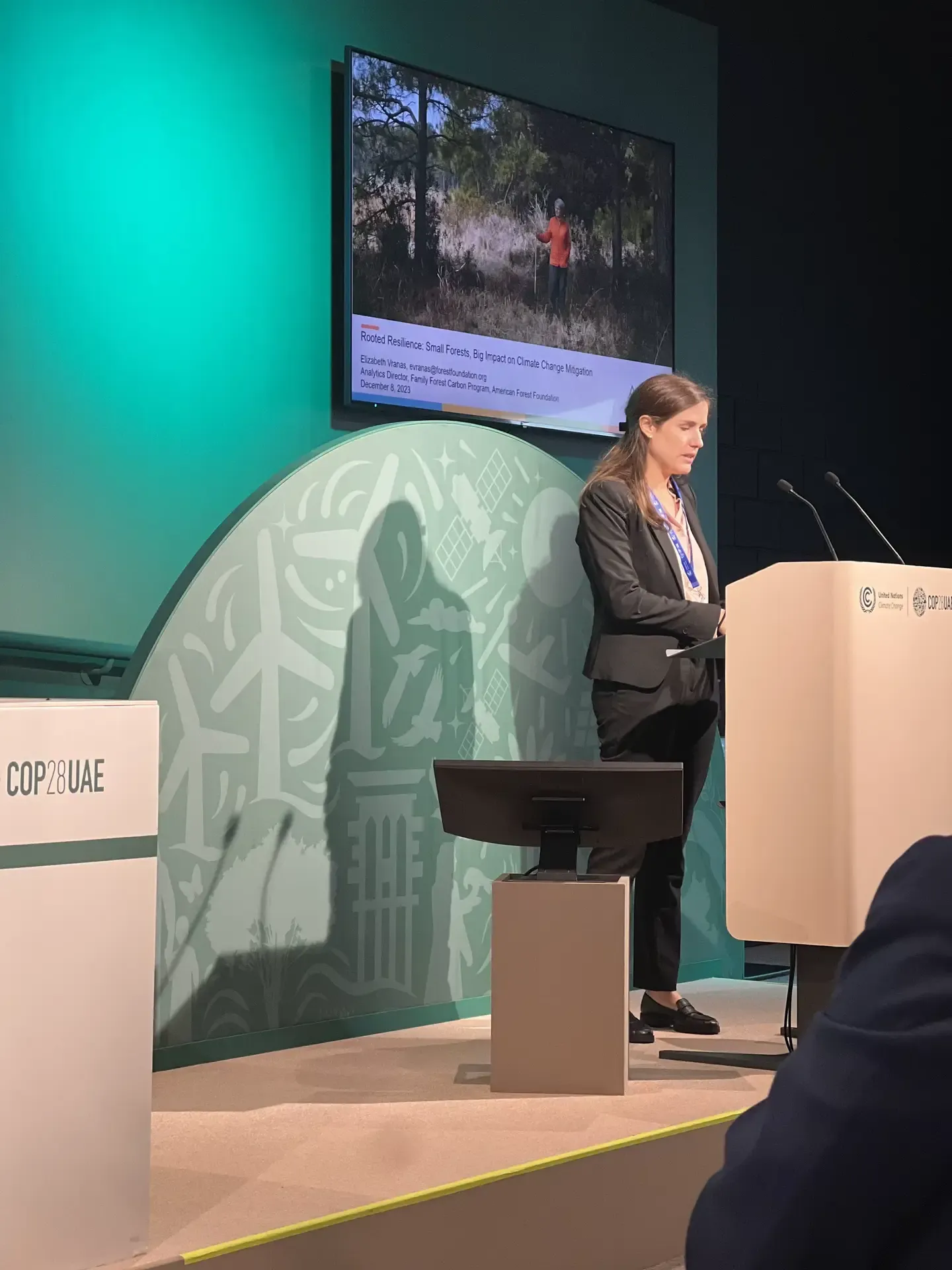The Voluntary Carbon Market is Reawakening – Let’s Make 2024 A Year of Action

A snowy forest at sunset.
This piece originally ran in Carbon Pulse
This year, the American Forest Foundation attended its second Conference of Parties, COP 28, held in Dubai. While many things came out of COP 28, and perhaps even more hoped-for things did NOT come out of COP 28, one incredibly important outcome concerned the voluntary carbon market’s role in the global struggle against climate change.
COP 28 reaffirmed the vital importance of carbon markets in keeping a 1.5-degree world within reach. The voluntary carbon market is the most viable mechanism for funding natural climate solutions at scale, transferring financing from corporations to projects and communities working to improve land management, restore ecosystems, and protect forests and other carbon sinks.

AFF's Nate Truitt, EVP, Climate Funding, stands with Maya Solomon, Director of Policy and Advocacy at COP28
Companies have spent 2023 wary and cautious, desperate for a roadmap on how to take effective climate action and avoid unnecessary risks and public criticism. At COP28, that roadmap took center stage. A slate of announcements brought signs of much-needed guidance for buyers, project developers, and the entire market.
Clarity For Buyers
First, COP offered good news for buyers wanting to take climate action with confidence. The VCMI, IC-VCM, We Mean Business Coalition, Climate Disclosure Project, Science Based Targets Initiative, and Greenhouse Gas Protocol came together to announce the development of an “end-to-end integrity framework” to provide consistent guidance on corporate decarbonization and the role high-quality carbon credits must play in enhancing corporate climate ambition. This end-to-end integrity framework will support corporates by making clear what approaches are needed to decarbonize their operations and value chains, and what guidance to follow in using high-integrity carbon credits to address their remaining emissions. After years of navigating a soup of terms and options, corporates will now have a clearer pathway to action with this framework.
One can almost forgive corporations for sitting on the sidelines for the majority of 2023, because for many companies and sectors the risk of action outweighed the risk of inaction. No longer. There are no more excuses. Companies have all the clarity they need to reduce and eliminate the emissions they can, while addressing those they cannot through the immediate purchase of and investment in high quality carbon credits.
Clarity for Project Developers
In order for buyers to have access to high-integrity credits, the market needs a clear, powerful definition of what good looks like, in order for buyers to distinguish between high-integrity credits that represent real atmospheric change, produced in line with other important safeguards. Thankfully, the work of the Integrity Council on the Voluntary Carbon Market (IC-VCM) is poised to provide just such a definition. IC-VCM was very forcefully present at COP 28, sharing the progress they’ve made to date on establishing the Core Carbon Principles and assessing both global carbon programs and project types against those standards. They committed to a timeline whereby the first CCP-labeled credits will begin trading in 2024.
Also at COP, 28 the world’s foremost carbon crediting programs (Verra, Gold Standard, Climate Action Reserve, ACR at Winrock International, ART and Global Carbon Council) announced the development of a framework to enhance integrity, transparency and consistency across the market. This framework will allow project developers to learn best practices from one another and align on common principles for carbon quantification.
For project developers, too, the time for excuses is past. We know the expectations of buyers and the market in regards to quality. From this point on, we should all expect project developers to bring projects to the market that reflect those expectations.

Elizabeth Vranas, Director of Business Analysis, FFCP stands at a podium to speak at COP28.
Market-wide Transparency and Scale
While greater standardization will help ensure the integrity of carbon credits, realizing the carbon market’s full climate impact is dependent on getting to scale. At COP, there were two announcements that offered vital steps towards integrating carbon markets into regulated financial markets, which will allow for more investment. The US Commodity Futures Trading Commission published a set of voluntary carbon credit trading guidelines designed to help do this. The published guidelines are aligned with the IC-VCM's Core Carbon Principles and raise a new bar in market-wide transparency. Additionally, IOSCO issued 21 principles for financial market integrity, including sound market structures, sound and orderly trading, and transparency and data availability and accessibility.
All of this is excellent. The voluntary carbon market, like any market, needs rules and frameworks to increase the confidence of suppliers and buyers alike. COP 28 showed that those frameworks are either already present or rapidly coming into existence. So what’s next?
2024: A Year of Action
A lot of commentary coming out of COP 28 is about what wasn’t decided or what didn’t get done. While it’s certainly true that more clarity could have been achieved about the role of markets overall, and the rules governing country-to-country trading were not finalized as we had hoped, don’t let that distract you from all that was made clear.
All of these announcements we discussed above raise the bar on integrity for the market. The progress at COP28 should be celebrated and should reinvigorate everyone working to fight climate change. The guidelines and frameworks announced at COP remove barriers preventing companies from investing in the carbon market. There will now be more guidance on what a high integrity credit is, how to trade them, and how to integrate them into a climate mitigation hierarchy.
These rules are “good enough” at this point that we should immediately shift the majority of our resources not to ironing out the few remaining details, but to action. Action to preserve our forests and other carbon sinks. Action to improve the management of working lands through providing communities with the financial and technical assistance they need. Along the way, we can continue to refine the structures, frameworks and rules as we go and as we learn. But the time of endless debate over the market is over, the time to put the market to work, urgently and at an unprecedented scale, has come.
If 2023 was the year in which everyone waited to see who would act first, COP was the moment companies, standards agencies, governments, and communities all stepped up and worked together to bring greater integrity to the voluntary carbon market. There are now fewer and fewer reasons for a company to avoid investing in the carbon market and as our planet inches closer to an unsustainable level of warming, more and more urgency for corporations to act.
So this is our call to corporations this coming year: set VCMI targets, invest in high-integrity carbon projects, and take any and all action in the fight against climate change. Our planet depends on it.
Related Articles

December 20, 2023
We’re Making the Voluntary Carbon Market Work for Rural America
As the UN Framework Convention on Climate Change (COP28) ends, I’m grateful to know that AFF is representing the interests of U.S. family-owned forests

December 20, 2023
The Voluntary Carbon Market Is Here to Stay – Now Let’s Make It Work for Rural America
If there’s one thing to take away from COP28, it’s that nature is undoubtedly an indispensable element to avoiding climate catastrophe.

December 21, 2023
The Fight Against Climate Change Needs Nature
At COP28 earlier this month, the American Forest Foundation had the privilege of sharing our work with family forest owners to tackle climate change.